With the rise of technology, the approach to education has been transformed beyond recognition. Just several dozen years ago nobody used a computer for studying, and now voila — almost every student has a laptop or PC and actively utilizes educational platforms, while teachers use tech to make their important mission a bit easier to complete.
Nowadays, there is a plethora of various systems intended for educators and learners, and which to choose depends on the demands and aims you want to achieve. Are you a student needing an all-in-one platform with virtual teachers that would track your progress and issue certificates? Or do you run a small private school and need target-specific software assisting in creating an individual education plan adapted for a concrete student?
As you understand, all is feasible; you just need to decide on your aims and requirements; however, this may be a complex mission itself. In this blog post, let’s discuss how to create an educational app, which types exist on the market, how they facilitate the learning process, and things to better envisage when getting down to development.
Sorting Things Through or Which Education App Types Exist on the Market

Complex Feature-Packed Educational Platforms
Let’s start our discussion with an application embracing the largest set of functions. We all know such platforms as Udemy or Coursera, and their feature package is indeed impressive. In other words, they represent a complex educational environment where you can find various useful content. There is a possibility of creating a personal learning or career development path, and of course, its capabilities include knowledge assessment through testing.
Unlike Udemy- or Coursera-like platforms where learners consume previously prepared content, there is another class of systems serving like marketplaces. In this case, we mean platforms for educational organizations or private teachers providing their services in one-on-one or group format. The flow is the following: teachers register on a website and learners book lessons with a concrete teacher.
Knowledge Assessment Platforms
From complex multi-purpose applications incorporating bunches of functions, let’s consider another group of systems aimed at a separate component of the educational process. The first example we’d like to offer here is a type of app aimed at learners’ knowledge evaluation.
For many years, our engineering team has been working on a system automating one-on-one assessments for primary schools. Within the application, educators are enabled to create, edit, share, and publish tests, build performance reports on students’ performance.
Obviously, system functionality doesn’t go beyond this one educational aspect. However, it solves the issue comprehensively, aiding teachers in evaluating pupils’ knowledge from all angles.
Scheduling Apps
Typically, the educational process in schools and universities revolves around class schedules, which must be created in advance. Yet, this is no simple task. Schedulers must account for room availability, teacher schedules, curriculum requirements, and the lessons that need to be conducted — all while ensuring everything runs smoothly.
So, how can all these factors be managed without causing confusion? The answer lies in scheduling apps. These systems are designed to streamline the scheduling process, resolve conflicts, and maintain a balanced workload for both teachers and students. By automating and optimizing the scheduling process, these tools help ensure an efficient and well-organized educational environment.
Learn how we built a Scheduling System for a Dental Marketplace
Communication Apps
Teachers and students’ parents must interact regularly. Whether a pupil suddenly gets sick and is unable to visit school or there are alterations in a timetable — both parties must have the possibility to promptly notify each other if there is such a need.
Of course, a mobile phone can be used, but agree, it’s not always convenient, especially if a teacher has 20+ students in a class and has to contact each of their parents. It’s much easier to do so through a special communication app represented by a secure messenger.
Sure thing, parties can not only send notifications to each other; as a rule, such systems also feature calendars, media file sharing, and more — depending on what is needed.
Learning Gamification Apps
Sparking interest in the educational process, especially for younger students, can often be a challenge. Yet, there is a solution: introducing gamification into learning. By integrating game-like elements such as rewards, challenges, and interactive content, educational experiences become more engaging and enjoyable for students of all ages.
Learning gamification apps transform traditional lessons into fun and interactive experiences that motivate students to participate more actively. These systems not only capture attention but also foster a deeper connection to the material, encouraging better retention and a love for learning. Through achievements, points, and progress tracking, students are inspired to challenge themselves, leading to improved academic outcomes.
Class Planning App
It’s not a secret that teachers have to perform many other functions beyond teaching itself. They have to deal with paperwork, create all sorts of reports, keep in touch with parents, and of course, create plans for their classes.
Taking note of the fact that a teacher conducts lessons every day for students of different levels, they have to sketch blueprints for each class in advance to be well-prepared and present the material clearly and professionally.
Along with the system for one-on-one assessment for the client we mentioned above, we elaborated on the application helping to create individual lesson plans. It worked as follows: there was a library with materials, and the system created a backbone of a class on its basis, which significantly alleviated the educator’s preparation for classes.
Obviously, such applications can not only be used as a sort of a cheat-sheet for a teacher. The system can also resolve the issue of content visualization by creating slide shows or interactive videos. Moreover, the system easily integrates with artificial intelligence to automate content generation.
Discover the Role of AI in Education and If It’s an Invaluable Tool or a Phantom Menace
Human Resources App
Like any other organization, educational facilities face staff shortages and turnover, pains related to searching and development of professional teachers, and many other personnel-related issues. That’s why they can’t do without using human resources applications.
One of your teachers accidentally got sick and needs a one-time replacement urgently? Certification or qualification improvement time is approaching, and you need to monitor your teammate’s progress? Received a complaint from students’ parents and need to find another educator for long-term cooperation? All these pains can be relieved with a specific application to ensure continuity of the educational process.
Accounting and Payroll Systems
Why would you include standard accounting and payroll systems in this list, you may ask? Sure thing, each organization has its own one; however, each has specifics worth mentioning, including the education sphere.
First, payroll calculations for teachers and educational staff are far from standard. Unlike many other professions with more predictable pay structures, the accounting department at schools and universities must make allowance for numerous variables when preparing a pay stub. Factors such as extra hours — often fluctuating from month to month — must be considered. Additionally, teachers may receive pay increases for improving their qualifications, obtaining certifications, or taking part in professional development programs.
Furthermore, many teachers take on extracurricular responsibilities, such as leading clubs, coaching sports teams, or arranging special events for students. These activities, often outside of regular school hours, add another layer of complexity to payroll management.
Defining the Functionality. Features an Effective Education App Must Incorporate
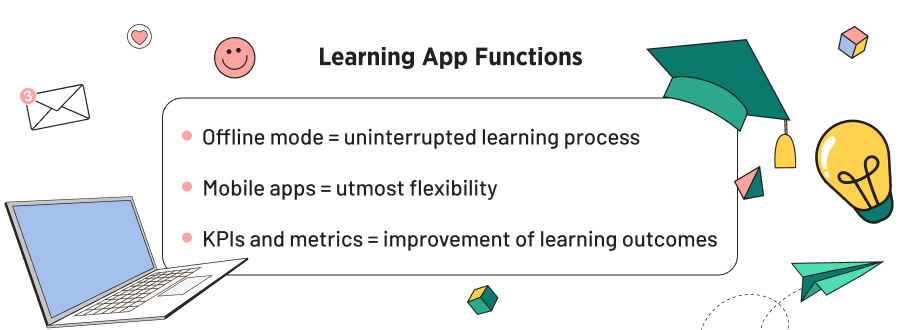
The feature set one educational application incorporates depends on the pains you intend to resolve with it and may be truly extensive. Thus, it makes little sense to list each and every nice-to-have function an abstract learning system should possess. However, let’s go over several and most essential ones worth considering when developing an educational app.
Offline Mode
There are times when users find themselves in situations with limited or no internet access — whether on a long flight, commuting in areas with poor connectivity, or in remote regions. In such cases, the inability to access educational content could disrupt the learning process.
When you create an educational app that supports offline functionality, you empower users with the possibility to download lessons, assignments, and resources in advance and continue their learning journey even without an internet connection.
Check out how we created a Mobile Learning Framework for Offline Educational Apps
Go Mobile
Learners do not always have an opportunity to use a laptop or a PC for studying, especially if we speak about specific groups, such as doctors. Despite their load, they still have to allocate some time to improve their qualifications and gain certificates, and the need to study on the go is not a whim in this case. For these purposes, educational mobile app development is essential.
Also, it’s better if such an app supports different formats, say, audio. A conditional doctor has a possibility to listen to an educational podcast anytime, be it commuting to work or doing the dishes at home. This was the feature one of our clients particularly requested to include in their medical application — the ability to download educational module podcasts to an iPhone, allowing doctors to listen to them offline during their spare time.
Learn about Medical Education Software, Its Specifics and Challenges
KPI and Metrics Tracking
Tracking KPIs and metrics in educational applications is a basic yet vital component. Why so? Learning is not just about absorbing information; it involves achieving measurable outcomes.
These outcomes must be tracked and evaluated to gauge progress and highlight areas for improvement. Without clear performance indicators, it becomes difficult to assess a learner’s knowledge, identify strengths or weaknesses, and make necessary adjustments to the educational program.
Measuring key metrics provides valuable insights into how effectively a student is mastering the material. It allows for the adaptation of learning pathways, helping to offer more personalized content where needed. Educators can better understand where students excel and where they struggle, tailoring their teaching strategies to support students’ growth.
Laying the Groundwork. Things to Know Before You Start Developing an Education App
The System Must Be Open for Integration
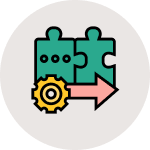
Let’s consider one example from our own experience. Some time ago, we built a system for medical education where doctors passed tests and the results must have been reported to a central authority. Put simply, the application sends transferred data to an external system on a regular basis, which becomes possible if it is open for integrations.
If you build an education app and don’t envisage this, you will inevitably face issues related to its synchronization with other systems, whether internal or external. It’s crucial to consider this from the outset when designing the app and plan for a robust API that facilitates seamless data exchange with external software or cloud-based solutions.
Read about Cloud Integration and How to Build Bridges Between the Elements of Your Infrastructure
System Usability
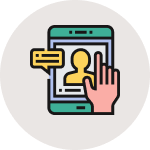
When you build an educational app, it’s essential to approach the design from the user’s perspective. Think about how a potential learner or educator will interact with the system. Is the design visually appealing? Are the buttons conveniently placed, and is the overall user interface intuitive and easy to navigate?
A well-designed platform significantly enhances the user experience. A clear, neat, and eye-pleasing education app design can make a huge difference in how easily users engage with the system. If the layout is confusing or cluttered, it can create frustration, leading to decreased usage or inefficiency in learning.
Find out Why Having a UX Strategy Is a Must for Successful Software Projects
Interaction with Subject Matter Experts
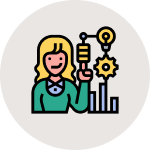
Teachers, methodists, and authors of educational courses may have their own specific way of seeing things that may run counter with business owners and those developing educational apps. They may also be quite reluctant to accept new systems and even changes in already used ones.
Here, we have one vivid example worth sharing with you. Our team has been developing a one-on-one assessment platform for many years, and its look and feel hadn’t been altered for almost twenty years! They conducted the full interface redesign a little while ago, and it’s not because there was no budget allocated for this purpose.
No, they just realized the potential confusion from the side of the teaching staff using the application daily, who would definitely be perplexed even if several buttons were suddenly moved. Sure thing, the platform functionality had been growing through all these years; it’s just the interface that remained unchanged.
That’s why, when you build an education app, take into consideration the visions of your potential users. It’s highly recommended not to conduct redesigns, even minor ones, too frequently and not to ignore training for your teaching staff.
Read about the Redesign of a High School Sports Coverage Website
System Scalability In All Terms
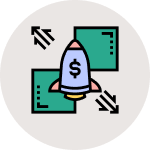
Do you create an educational app targeted at a wide audience? If yes, it’s better to be preoccupied with the application’s scalability. Let’s return to the example of the one-on-one assessment platform we are working on. In the very beginning, when the customer just turned to us, their requirements didn’t include a high load.
However, their platform had been acquiring new users quite quickly, and in approximately a year, the source configuration with only one server ceased to satisfy the client. Obviously, our team managed to resolve this pressing problem; however, it could have been done with far less effort if the system had initially been scalable enough.
Another point is functionality growth. When designing an educational platform, you should be ready for the scenario that it will be transformed and expanded, even though, at this very moment, you consider it an unnecessary whim. Therefore, it’s better to design a modular, expandable, and easy-to-integrate with sub-systems, both external and within the platform itself.
Selecting a Partner for Education App Development — Our Approach
Selecting a software development partner to make an educational app is a challenging and time-consuming task that requires careful consideration of several factors. The first priority is reliability — you need a partner that you can trust to deliver on time and handle the complexities of the project.
Relevant expertise is equally essential. The development team should have a deep understanding of the education sector, its unique requirements, and the latest technologies that can be applied to enhance the learning experience.
Budget fit is another important factor. It’s essential to find a partner who can work within your financial constraints without compromising on quality. Balancing cost-efficiency with high standards of delivery is often a difficult task, but it’s crucial for ensuring the long-term success of the project.
Our approach is highly flexible. When a potential client reaches out, they define the task, project objectives, and key challenges they need to address. From there, we focus on delivering a commercially efficient solution tailored to meet their specific requirements. Here’s how the process unfolds:
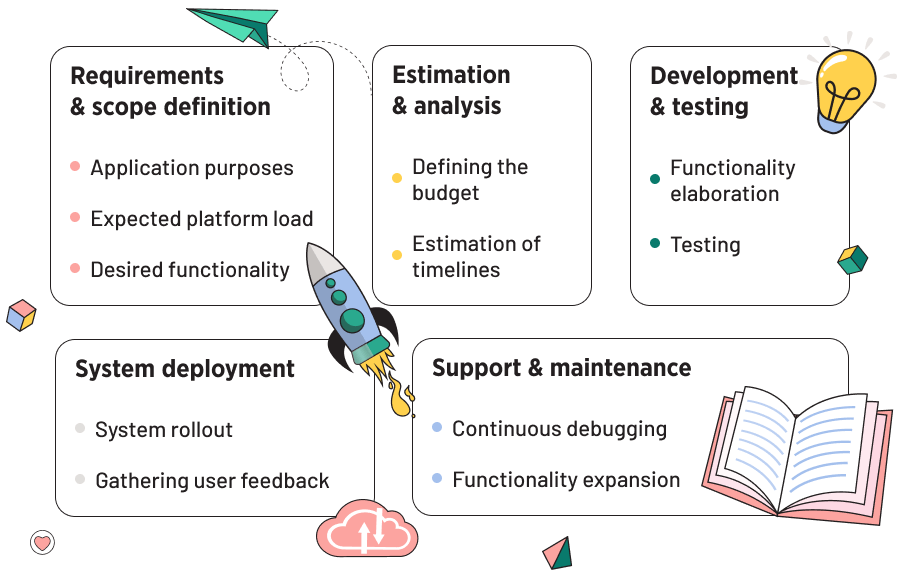
Throughout our work, we’ve gained significant expertise in education application development, including specialized platforms for medical learning. Our deep understanding of the domain allows us to develop fully customized, efficient solutions from scratch. Additionally, we offer proprietary tools and resources that can be integrated into client projects to help speed up time-to-market and reduce costs.
Get in touch with us and let our expert team help you make a tailored, cost-effective education app designed to meet the needs of learners and educators!









